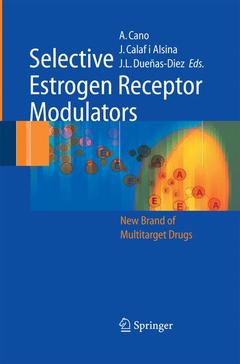Description
Selective Estrogen Receptor Modulators, 2006
A New Brand of Multitarget Drugs
Coordinators: Cano Antonio, Calaf i Alsina Joacquim, Duenas-Diez Jose Luis
Language: English
Subjects for Selective Estrogen Receptor Modulators:
Selective Estrogen Receptor Modulators
Publication date: 10-2014
357 p. · 15.5x23.5 cm · Paperback
Publication date: 10-2014
357 p. · 15.5x23.5 cm · Paperback
Selective Estrogen Receptor Modulators
Publication date: 06-2006
357 p. · 15.5x23.5 cm · Hardback
Publication date: 06-2006
357 p. · 15.5x23.5 cm · Hardback
Description
/li>Contents
/li>Comment
/li>
The increasing awareness on the varied consequences of hypogonadism in distinct organs and systems has supported the notion of estrogens as systemic agents. This observation is congruent with the variety of tissues affected by - trogens when used in hormone therapy formulations on hypogonadic women. Apart from the genital tract and the breast, recognized as traditional targets for estrogens, the skeleton, the vascular tree, or the central nervous system, are good examples of territories that have demonstrated sensitivity to estrogens. This evidence has created great interest, as shown by the great amount of lit- ature that has been produced on the bene?ts and risks associated with the use of estrogens. In parallel to the clinical interest, basic research has improved our kno- edge on the complexities involved in estrogen action at the molecular level. Together with effects mediated through speci?c receptors, a concept that has been the mainstay of the interpretation of estrogen action for years, there is enough evidence to hold the notion of receptor-independent effects. The substantial advances in modern technology applied to research have helped in enlightening the particulars of this versatile action of estrogens. This more detailed knowledge on the sophisticated mechanism of action of estrogens has nourished the emergence of multiple hypotheses speculating with the p- sibility of manipulating estrogen action. The notion that a widely extended regulatory system of cell function, as it is the estrogen receptor machinery, might be modulated at wish has arisen as an attractive, although still elusive postulate.
Basic Area.- Molecular Mechanisms of Estrogen Action in Target Tissues.- Clinical Pharmacology of Selective Estrogen Receptor Modulators (SERMs).- Action of Selective Estrogen Receptor Modulators (SERMs) Through the Classical Mechanism of Estrogen Action.- Cellular and Molecular Basis for Acute Nongenomically Mediated Actions of SERMs.- The Hypothalamus-Pituitary-Ovarian Axis as a Model System for the Study of SERM Effects: An Overview of Experimental and Clinical Studies.- Pure Antiestrogens.- Clinical Area.- Physiological Regulation of Bone Metabolism and Estrogen Agonism.- The Role of SERMs in the Treatment of Osteoporosis.- Cardiovascular Disease and SERMs.- SERMs and the Breast.- Endometrial Effects of SERMs.- Benign Gynecological Diseases and SERMs.- Other Clinical Effects of SERMs.- The Role of SERMs in the Management of Postmenopausal Women.
Offers an updated view of the main advances on selective estrogen receptor modulators (SERM)
first part reviews the main basic concepts
second part concentrates on the recent news on the many uses of SERM in clinical practice
Includes supplementary material: sn.pub/extras
© 2024 LAVOISIER S.A.S.




